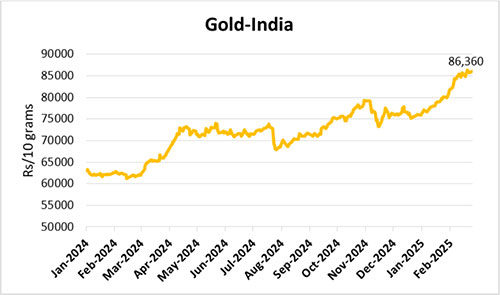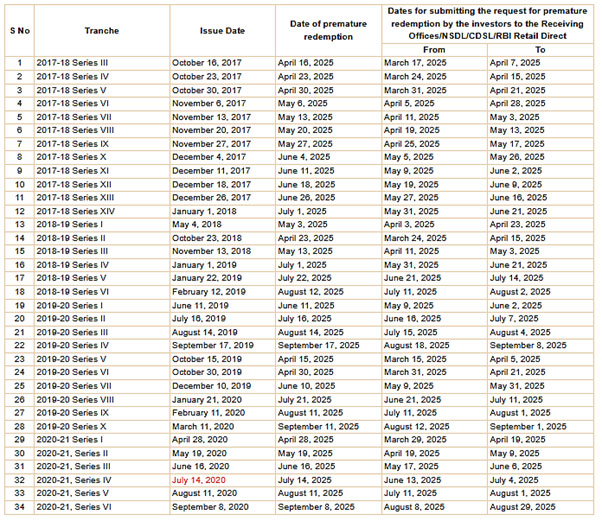RBI’s Sovereign Gold Bonds Premature Redemption: What It Means for Gold Investors
Mitali Dhoke
Feb 25, 2025 / Reading Time: Approx. 10 mins
Listen to RBI’s Sovereign Gold Bonds Premature Redemption: What It Means for Gold Investors
00:00
00:00
Gold has been experiencing an unprecedented rally since 2024, hitting new highs in times of worldwide economic uncertainty. At the beginning of 2025, gold rates in India skyrocketed dramatically, with 24-karat gold selling at an all-time high of Rs 86,360 for every 10 grams as of February 19, 2025.
This spike is caused by numerous factors, ranging from geopolitical tensions to inflation pressures and massive purchases by central banks, especially in the emerging world. The latest gold rally owes much to investors who seek safe-haven assets in the wake of market turbulence.
As major economies experienced slowdowns in growth and geopolitical tensions rose, gold's role as a hedge against uncertainty has grown, resulting in its sudden price appreciation. Central banks, especially emerging market ones, have also been piling up gold aggressively to diversify their reserves and reduce dependency on the U.S. dollar.
This sustained institutional demand, coupled with constrained supply and a weaker dollar, has further fueled the metal's bullish momentum. As gold continues its upward trajectory, investors are increasingly turning to gold-backed financial instruments like Gold mutual funds, Gold ETFs and SGBs for prudent investment purposes.
Sovereign Gold Bonds (SGBs) have been popular ever since for the advantages they provide, including tax-free maturity proceeds, sovereign guarantees, and the avoidance of storage issues in physical gold. There has been a void seen in fresh SGB issuances since February 2024, and this has generated speculation regarding the scheme.
[Read: Sovereign Gold Bond Scheme Discontinued: Why This is Done and What It Means for Investors]
This uncertainty has escalated due to debate in the aftermath of the Union Budget 2025 and the latest updates from the Reserve Bank of India (RBI) related to premature redemption alternatives for present bondholders.
On February 21, 2025, the RBI issued a press release, outlining the details of the SGB tranches that are scheduled for premature redemption between April and September 2025. It also outlines a window for submitting requests if investors want to encash the SGB via premature redemption.
What are Sovereign Gold Bonds (SGBs)?
SGBs are government-backed securities denominated in grams of gold. Unlike physical gold, they offer a fixed annual interest rate of 2.5% p.a and are free from storage and purity concerns. The primary advantages of SGBs include capital appreciation linked to gold prices, exemption from capital gains tax if held until maturity, and sovereign backing, ensuring safety and transparency.
Introduced by the Reserve Bank of India (RBI) in 2015 under the Gold Monetization Scheme, SGBs provide returns linked to gold prices along with an additional fixed interest rate.
Over the years, SGBs have delivered strong returns, averaging 9-11% per annum, making it an attractive long-term investment. Since the launch, the price of gold has been on a consistent upward trend amidst economic uncertainty and geopolitical tensions, reinforcing its reputation as a haven or a store of value.
Graph: Safe-Haven Demand Pushes Gold to Record Levels
 Data as of February 24, 2025
Data as of February 24, 2025
Past performance does not guarantee future results
(Source: MCX, data collated by PersonalFN Research)
As you can see, over the past year, gold prices have surged by approximately 35%. However, with soaring gold prices and a growing redemption liability, SGBs have also become increasingly costly for the government.
The rising fiscal burden due to interest payouts and capital appreciation-linked redemptions has prompted discussions on the financial sustainability of the scheme, leading to the need for premature redemption measures and potential policy recalibrations.
Why SGBs Are Becoming Unsustainable
The burden stems from the two-way payment structure. On the government's side, there is the cost of calibrating the 2.50% interest paid annually, which is a separate cash flow irrespective of movement in the markets. On the investor's side, at the time of redemption, they receive the current market price of gold, which has risen considerably over the years.
The sudden spike in gold prices has significantly increased redemption liabilities and made it increasingly challenging for the government to maintain payouts.
Also, with SGBs becoming increasingly popular, the outstanding liabilities increase. The RBI has been issuing several tranches of SGBs since 2015, and investors have been attracted in increasing numbers to the tax advantages and security of sovereign guarantee. The compounded pressure of increasing redemption liabilities and cumulative interest payments takes a toll on government finances, particularly when fiscal deficit issues continue to be a priority.
[Read: Have Sovereign Gold Bonds Lost Sheen After Modi 3.0's Full Budget 2024-25]
Considering the long duration of these bonds (eight years), the overall outflow at maturity can be heavy if gold prices are high. To meet these financial challenges, RBI has chosen to permit early redemption and it shows the government's attempt to balance investors' interests while maintaining fiscal prudence.
Table: Scheduled Premature Redemption Window for SGBs (April-September 2025)
 (Source: RBI - SGBs Premature Redemption Schedule)
(Source: RBI - SGBs Premature Redemption Schedule)
For investors, SGBs continue to be a preferred instrument due to their tax efficiency, stability, and sovereign guarantee. Nevertheless, the scheme's sustainability from a policy standpoint is still uncertain. Hence, investors need to keep in mind possible policy changes while making long-term gold investments.
Moreover, promoting other gold investment channels, such as gold ETFs or gold in digital forms, may decouple dependence from SGBs while still fostering organized gold investments.
Gold ETFs Gaining Popularity: Why Investors Are Making the Switch
Unlike traditional gold investments, Gold ETFs offer convenience in trading, liquidity, and safety, which has made them the preferred option among contemporary investors. As gold prices continue to escalate and market volatility rises, investors are increasingly looking towards these instruments as a good hedge against inflation and economic unpredictability.
Increased geopolitical tensions and economic uncertainty have turned gold into a highly desirable asset among investors looking for a cushion. The global trade wars and protectionist policies have raised fears of economic slowdowns. Nations increasing tariffs on each other, in addition to volatile commodity prices, have created market volatility in equities.
[Read: What's Driving Record Inflows into Gold ETFs]
The trio of foreign institutional investors (FIIs) pulling out money, a depreciating rupee, and volatile corporate earnings have subdued investor sentiment. Although equities have posted high returns over the past few years, the heightened risk perception is now compelling investors to shift to safer assets such as gold.
Further, as interest rates are unpredictable in the world and central banks are being cautious, risk-averse investors are switching money from equities to gold-backed investments. Since gold has traditionally been used as a haven asset during times of financial crises, demand for Gold ETFs has been increasing as a tool for hedging portfolios against worldwide economic shocks.
With the non-issue of fresh SGB tranches, Gold Exchange Traded Funds (ETFs) have become the first choice among gold investments. Nevertheless, they don't come with the added fixed interest SGBs used to offer. Thus, gold investors might need to rechart their strategies based on liquidity requirements, taxation, and long-term investment goals.
To Conclude...
Despite the discontinuation of Sovereign Gold Bonds (SGBs), gold continues to be a good investment option, particularly during times of economic uncertainty globally. For 2025, the outlook for gold is also upbeat and it is expected to maintain its status as a safe-haven asset. Furthermore, in India, continued demand for gold, especially during festivals and wedding seasons, will keep its price underpinned.
Technological advancements in gold trading, as well as regulatory progress, could also make gold investing more transparent and accessible. Though gold can be subject to short-term fluctuations, its long-term direction is encouraging for investors who wish to hedge against economic instability and currency movements.
However, investors may consider their investment goals and risk tolerance before deciding on the most suitable gold investment vehicle.
We are on Telegram! Join thousands of like-minded investors and our editors right now.
MITALI DHOKE is a Research Analyst at PersonalFN. She is an MBA (Finance) and a post-graduate in commerce (M. Com). She focuses primarily on covering articles around mutual funds including NFOs, financial planning and fixed-income products. Mitali holds an overall experience of 4 years in the financial services industry.
She also actively contributes towards content creation for PersonalFN’s social media platforms in the endeavour to educate investors and enhance their financial knowledge.
Disclaimer: Investment in securities market are subject to market risks, read all the related documents carefully before investing.
This article is for information purposes only and is not meant to influence your investment decisions. It should not be treated as a mutual fund recommendation or advice to make an investment decision in the above-mentioned schemes.